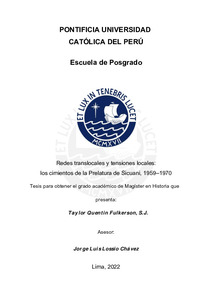| dc.contributor.advisor | Lossio Chávez, Jorge Luis | |
| dc.contributor.author | Fulkerson, Taylor Quentin | |
| dc.date.accessioned | 2022-11-16T16:23:09Z | |
| dc.date.available | 2022-11-16T16:23:09Z | |
| dc.date.created | 2022 | |
| dc.date.issued | 2022-11-16 | |
| dc.identifier.uri | http://hdl.handle.net/20.500.12404/23793 | |
| dc.description.abstract | A mediados del siglo XX, la Iglesia católica en América Latina experimentó una
renovación institucional: por un lado, articuló nuevas redes entre los episcopados
nacionales para crear una Iglesia continental, y por otro, se estableció un "triángulo"
entre Latinoamérica, el Vaticano y los países norteamericanos y de Europa occidental.
Los principales resultados — nuevas jurisdicciones eclesiásticas y nuevos agentes
pastorales— se convirtieron en espacios y modos de praxis disputados a través de los
cuales se intentó llevar a cabo las reformas del Concilio Vaticano Segundo y Medellín.
Esta tesis investiga estas dinámicas translocales a través de la experiencia de la
Prelatura de Sicuani, que se fundó en 1959 como una nueva jurisdicción eclesiástica
para las provincias altas de Cusco. Como caso ejemplar, vemos que la prelatura recibió
a misioneros carmelitas de Estados Unidos y Canadá y sus colaboradores: clero secular
extranjero, hermanas y voluntarios laicos. Con el optimismo mundial de la década del
sesenta, estos actores crearon redes para dirigir recursos, ideas y personas hacia las
provincias altas de Cusco, generando a la misma vez tensiones entre su línea pastoral
de catolicismo purificado y el catolicismo altoandino.
Este estudio parte del supuesto de que la fundación y reorientación de la Iglesia
local en la Prelatura de Sicuani respondió a una extensa red translocal de influencias,
la cual marcó la historia social de las provincias altas de Cusco. El método de análisis
incluye el cruce de fuentes y narrativas, empleando documentos del archivo de los
carmelitas norteamericanos que asumieron la prelatura, del Archivo Arzobispal del
Cusco y los periódicos cusqueños El Sol y El Comercio. | es_ES |
| dc.description.abstract | In the mid-20th century, the Catholic Church in Latin America experienced an
institutional renovation: on the one hand, it articulated networks between the national
episcopacies to create a continental Church, and on the other, a "triangle" between Latin
America, the Vatican, and the countries of North America and Western Europe was
established. The principal results — new ecclesiastical jurisdictions and new pastoral
agents — would become disputed spaces and modes of praxis through which the Church
tried to bring about the reforms of the Second Vatican Council and Medellín.
This thesis investigates these translocal dynamics through the experience of the
Prelature of Sicuani, which was founded in 1959 as a new ecclesiastical jurisdiction for
the high provinces of Cusco. An exemplary case, the prelature received Carmelite
missionaries from the United States and Canada and their collaborators: foreign secular
clergy, sisters, and lay volunteers. With the optimism of the global 60s, these actors created networks to direct resources, ideas, and people toward the high provinces of
Cusco, at the same time generating tensions between their pastoral line of purified
Catholicism and the Catholicism of the high Andes.
This study sets off from the presupposition that the foundation and reorientation
of the local Church in the Prelature of Sicuani responded to an extensive, translocal
network of influences, which marked the social history of the high provinces. The method
of analysis includes the crossing of sources and narratives, employing documents from
the archive of the North American Carmelites who assumed the prelature, from the
Archdiocesan Archive of Cusco and the Cusco newspapers El Sol and El Comercio. | es_ES |
| dc.language.iso | spa | es_ES |
| dc.publisher | Pontificia Universidad Católica del Perú | es_ES |
| dc.rights | info:eu-repo/semantics/openAccess | es_ES |
| dc.rights.uri | http://creativecommons.org/licenses/by-nc-nd/2.5/pe/ | * |
| dc.subject | Iglesia Católica. Prelatura de Sicuani (Perú)--Historia | es_ES |
| dc.subject | Iglesia Católica--Perú--Cuzco | es_ES |
| dc.subject | Misioneros | es_ES |
| dc.title | Redes translocales y tensiones locales: los cimientos de la Prelatura de Sicuani, 1959–1970 | es_ES |
| dc.type | info:eu-repo/semantics/masterThesis | es_ES |
| thesis.degree.name | Maestro en Historia | es_ES |
| thesis.degree.level | Maestría | es_ES |
| thesis.degree.grantor | Pontificia Universidad Católica del Perú. Escuela de Posgrado. | es_ES |
| thesis.degree.discipline | Historia | es_ES |
| renati.advisor.dni | 10002555 | |
| renati.advisor.orcid | https://orcid.org/0000-0001-9883-2048 | es_ES |
| renati.author.pasaporte | 461278498 | |
| renati.discipline | 222117 | es_ES |
| renati.juror | Cosamalon Aguilar, Jesus Antonio | es_ES |
| renati.juror | Lossio Chavez, Jorge Luis | es_ES |
| renati.juror | Espinoza Portocarrero, Juan Miguel | es_ES |
| renati.level | https://purl.org/pe-repo/renati/level#maestro | es_ES |
| renati.type | https://purl.org/pe-repo/renati/type#tesis | es_ES |
| dc.publisher.country | PE | es_ES |
| dc.subject.ocde | https://purl.org/pe-repo/ocde/ford#6.01.01 | es_ES |






